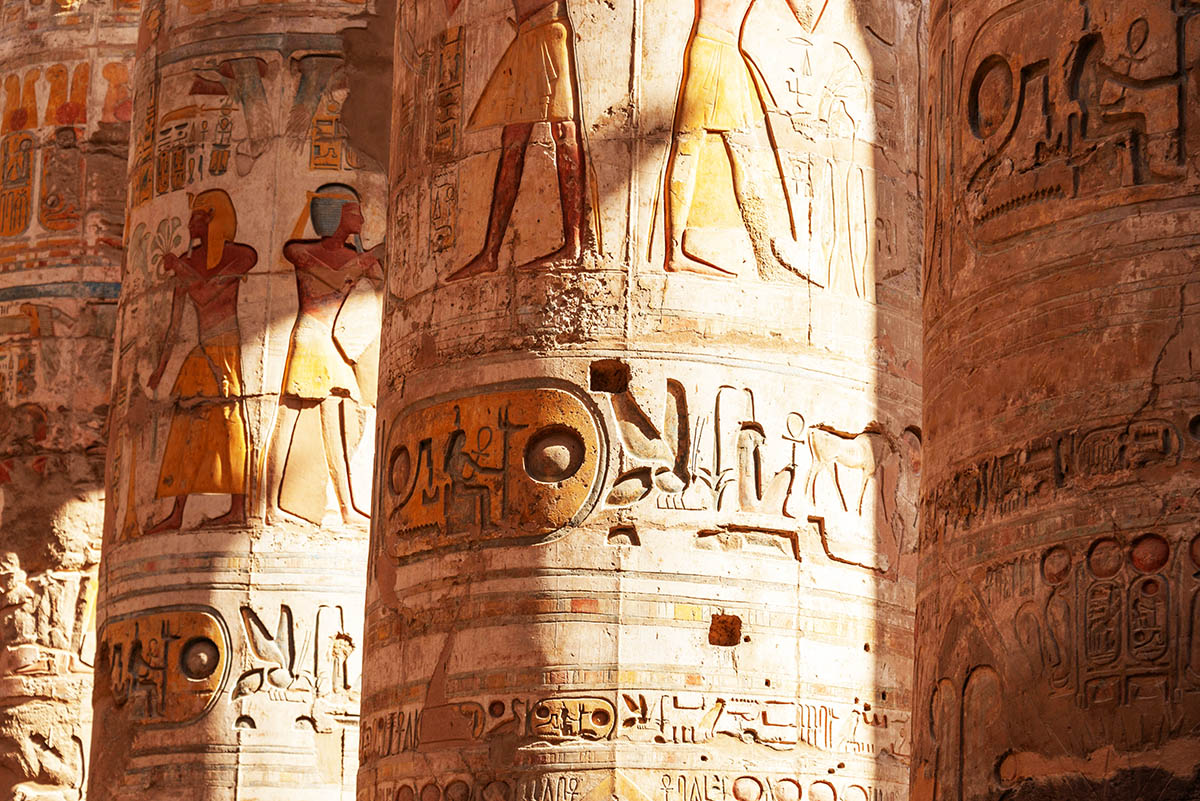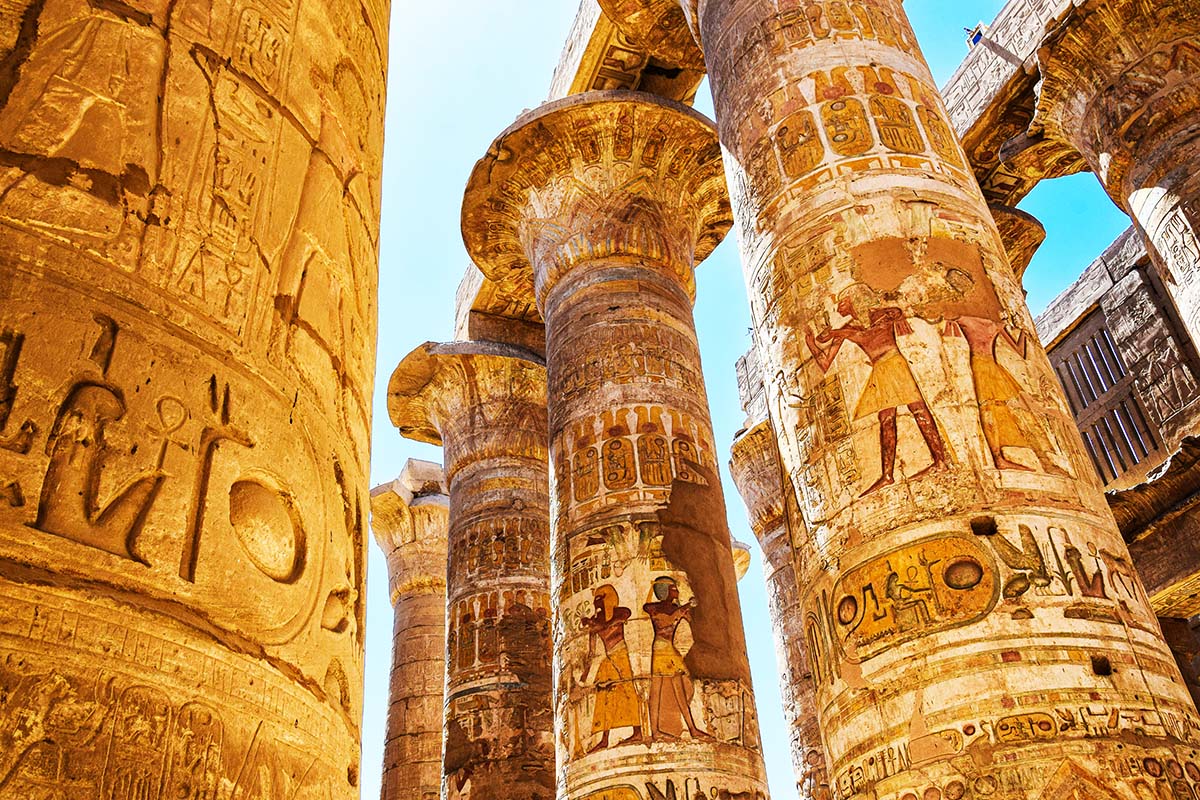Karnak Temples
Comprehensive Guide
Know Before You Go!
Overview
Introduction
The Karnak Temples, located in Luxor, Egypt, are one of the most remarkable and extensive temple complexes in the world. Spanning over 100 hectares, Karnak is dedicated to the Theban Triad Amun, Mut, and Khonsu, and served as a major religious center during the New Kingdom (c. 1550–1070 BCE).
The site is renowned for its colossal structures, intricate carvings, and vast courtyards, reflecting the grandeur and architectural prowess of ancient Egypt. Karnak was a place of worship, political power, and artistic achievement, making it a key destination for understanding the spiritual and cultural life of ancient Egyptians.
History
The construction of the Karnak Temples began around 2000 BCE during the Middle Kingdom and continued for over 1,500 years, with contributions from various pharaohs, including Senusret I, Hatshepsut, Thutmose III, and Ramses II.
The complex was primarily developed during the New Kingdom, where it became the center of the cult of Amun-Ra, the king of the gods. The Hypostyle Hall, a masterpiece of ancient architecture with its 134 massive columns, was built during the reign of Seti I and Ramses II.
The temple’s layout, consisting of sanctuaries, pylons, obelisks, and statues, evolved over centuries, reflecting the changing religious and political landscape of Egypt. Karnak was not just a religious site but also a symbol of the power and wealth of the pharaohs who built and expanded it.
Key Highlights
Main Attractions
- Great Hypostyle Hall: This vast hall, covering 5,000 square meters, is one of the most iconic features of Karnak. It is filled with 134 massive columns, some reaching heights of 21 meters, intricately carved with scenes depicting the gods and the pharaohs.
- Sacred Lake: A large man-made lake within the temple complex used for ritual purification. It is one of the oldest sacred lakes in Egypt and still holds water today.
- Avenue of Sphinxes: This processional road lined with sphinx statues once connected Karnak to Luxor Temple. The avenue is a testament to the grandeur of ancient Egyptian religious ceremonies.
- Temple of Amun-Ra: The largest and most significant temple within the complex, dedicated to Amun-Ra, the king of the gods. The temple contains the Sanctuary of Amun, the Festival Hall of Thutmose III, and several obelisks.
- Obelisks of Hatshepsut and Thutmose III: These towering stone monuments were erected to honor the gods and commemorate the pharaohs. Hatshepsut’s obelisk, in particular, is notable for its height and the inscriptions that recount her reign.
Unique Features
- Architectural Grandeur: Karnak’s vast scale and the complexity of its structures reflect the architectural achievements of ancient Egypt, showcasing advancements in engineering, design, and artistic expression.
- Religious Significance: As the heart of the worship of Amun-Ra, Karnak was a focal point for religious ceremonies, oracles, and the famous Opet Festival, which celebrated the divine connection between the pharaohs and the gods.
- Hieroglyphic Inscriptions: The walls and columns of Karnak are adorned with thousands of hieroglyphic inscriptions, providing valuable insights into the religious beliefs, rituals, and political history of ancient Egypt.
- Great Festival Hall of Thutmose III: This unique hall was built in the shape of a tent and used during the Opet Festival. Its columns and walls are decorated with scenes of Thutmose III’s military campaigns.
Visitor Information
Opening Hours
Daily: 6:00 AM – 5:30 PM
Admission Fees
- General Admission: 450 EGP
- Students: 230 EGP
* Tickets include the Avenue of Sphinxes
For the latest pricing updates and ticket bookings, visit www.egymonuments.com
Location
Address: Karnak, Luxor, Luxor Governorate
Tips for Visitors
- Early Visits: Arriving early in the morning can help you avoid the heat and the crowds, allowing you to explore the site in relative peace.
- Guided Tours: To fully appreciate the history and significance of the site, consider booking a guided tour. Click here
- Photography: The site offers incredible photo opportunities, especially around sunrise and sunset. Tripods may be useful but check for any restrictions.
- Conservation Areas: Some parts of the temple complex are under restoration or conservation efforts, so access may be limited.
Cultural Insights
- Rituals and Ceremonies: Karnak was a central hub for religious rituals, including offerings to the gods, purification ceremonies, and the Opet Festival, which involved the transport of the statue of Amun-Ra to Luxor Temple.
- Pharaonic Power: The expansion of Karnak over centuries symbolizes the growing power and influence of the pharaohs, who used the temple to legitimize their rule and connect themselves with the divine.
What to Expect
Exhibit Layout
The Karnak Temple complex is divided into several key areas, including the Temple of Amun-Ra, the Great Hypostyle Hall, the Sacred Lake, and various smaller temples and chapels. The complex is vast, so be prepared to spend several hours exploring.
Visitor Experience
- Majestic Structures: Walk among the towering columns of the Hypostyle Hall, marvel at the colossal statues of the gods and pharaohs, and feel the presence of history as you explore the ancient sanctuaries.
- Scenic Walks: The temple grounds offer picturesque views of the surrounding landscape, including the Nile River and the distant desert hills.
- Historical Exploration: Engage with detailed information panels and guides that provide context to the various structures, their significance, and their place in ancient Egyptian history.
Booking Information
For a more detailed itinerary and information on all available daily tours with ticket2egypt, please browse our tours here
Explore The Karnak Temples with ticket2egypt, Check out our exclusive Luxor East Bank Wonders Tour
For guided tours and personalized arrangements with ticket2egypt, please fill the below information and we will reply to you shortly
Close Attractions
Luxor Temple
Located just a few kilometers from Karnak, Luxor Temple is another key religious site that was connected to Karnak by the Avenue of Sphinxes.
Valley of the Kings
The royal necropolis where many pharaohs of the New Kingdom were buried. It is home to the tombs of Tutankhamun, Ramses II, and other notable rulers.
Temple of Hatshepsut
A unique mortuary temple built by one of Egypt’s few female pharaohs, located on the west bank of the Nile near the Valley of the Kings.
Luxor Museum
A museum that houses an impressive collection of artifacts from Luxor and the surrounding areas, providing additional context to the history of the region.
Ready to Embark on Your Egyptian Adventure? Contact Us or Book Now
Have a question or ready to plan your Egyptian adventure? Reach out to us via WhatsApp by clicking the button at the bottom left corner of your screen. Alternatively, you can fill out the contact form below, and we’ll get back to you promptly via email. We’re here to help you create unforgettable memories in Egypt!
Join us on Social Media and Get!
Stay connected and make the most of your Egyptian adventure with insider tips, breathtaking visuals, exclusive offers, cultural stories, and a vibrant travel community








